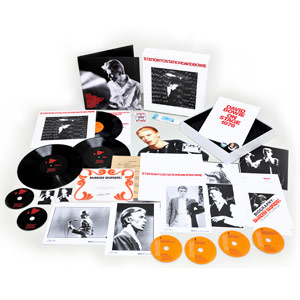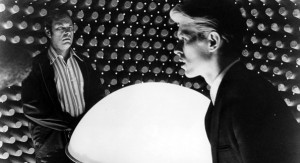 Much has been made of the effect of cocaine on David Bowie’s Station to Station, and how it led to a paranoid, schizophrenic masterpiece. I think it did something far more interesting: It made Bowie human. Starting with Ziggy Stardust, Bowie adopted a series of personae, each less convincing and artistically fruitful than the one before. The excellent, relatively concept-free Hunky Dory (1971) makes me wonder if that was simply the start of a hot period, and identifying Ziggy Stardust and Aladdin Sane as characters wasn’t a red herring that made it seem as if the songs on those albums flowed from the characters rather than vice versa. By Diamond Dogs and Young Americans, the strain to recreate himself yearly showed, and the albums suggest that more imagination went into the concept than the songs.
Much has been made of the effect of cocaine on David Bowie’s Station to Station, and how it led to a paranoid, schizophrenic masterpiece. I think it did something far more interesting: It made Bowie human. Starting with Ziggy Stardust, Bowie adopted a series of personae, each less convincing and artistically fruitful than the one before. The excellent, relatively concept-free Hunky Dory (1971) makes me wonder if that was simply the start of a hot period, and identifying Ziggy Stardust and Aladdin Sane as characters wasn’t a red herring that made it seem as if the songs on those albums flowed from the characters rather than vice versa. By Diamond Dogs and Young Americans, the strain to recreate himself yearly showed, and the albums suggest that more imagination went into the concept than the songs.
On Station to Station, there’s no obvious character. He identified himself during that period as the Thin White Duke, and introduced himself as such in the first line of the title song, but that name seemed to emerge from what he looked like and what he’d been doing rather than from some new, imagined creation. His look, the cover photo and promo imagery of the time all came from Nicolas Roeg’s The Man Who Fell to Earth, the movie he starred in earlier that year, playing the alien Newton.
 That adaptive quality—working with what was around him—gives Station to Station a more natural feel than the conceptually constrained Diamond Dogs and Young Americans, as if the songs fed the concept (such as it is), not the other way around. As such, there are no mawkish attempts at being a “soul singer”—though he’s often soulful—nor any pronounced gestures toward dystopian storytelling. “TVC-15” is about a dark vision about a man’s relationship with his television, but its fundamental bounce staves off the faux-ominous overtones that weighed down Diamond Dogs.
That adaptive quality—working with what was around him—gives Station to Station a more natural feel than the conceptually constrained Diamond Dogs and Young Americans, as if the songs fed the concept (such as it is), not the other way around. As such, there are no mawkish attempts at being a “soul singer”—though he’s often soulful—nor any pronounced gestures toward dystopian storytelling. “TVC-15” is about a dark vision about a man’s relationship with his television, but its fundamental bounce staves off the faux-ominous overtones that weighed down Diamond Dogs.
It’s probably no coincidence that Station to Station also featured a productive core band of Carlos Alomar, Dennis Davis and George Murray (led by Alomar), that fed his imagination in the same way that the emergence of Mick Ronson as his primary musical collaborator led to Bowie’s classics from his glam era. He not only had/didn’t have a persona, but he had a sound that was once again au courant and genuinely futuristic as it envisioned a dance rock that was as aware of what was happening in New York City dance clubs as it was of arena stages and krautrock albums.
The other find in the Station to Station box is the live show from the Nassau Coliseum from 1976. A recording on WolfgangsVault.com of another show on the Station to Station tour finds the band speeding to such a degree that it’s literally breathtaking. In the show packaged in the set, lead guitarist Stacey Haydon stands at his amp for a good couple of minutes, coaxing feedback out to simulate the train whistle at the start of “Station to Station,” and that patience manifests itself in the songs’ pacing throughout. That’s particularly valuable when Bowie rearranges some of his classics for the current lineup. “Suffragette City,” “Queen Bitch,” “Life on Mars” and “Panic in Detroit” all sound fresh. His bouncy take on the Velvet Underground’s “Waiting for the Man” may be more carefree than suits the song’s subject matter, but at least it’s unexpected. The show only starts to flag as a listening experience as it ends with reasonably faithful renditions of “Diamond Dogs,” “Rebel Rebel” and “The Jean Genie,” though I suspect that ending would have been brilliant in person.
The box also comes with numerous mixes of the album on CD, DVD and vinyl, packets of memorabilia, and a disc of singles mixes, the two most interesting being “Station to Station” and “TVC-15.” In the case of the former, the attempt to trim the 10-minute track down to three-plus minutes is laughable, and in an effort to make the song more palatable for AM airplay, the volume is lowered on the line “It’s not the side effects of the cocaine / and I’m thinking that it must be love,” which is also slightly blurred, enough that I had to re-listen to it three or four times to be sure that it hadn’t been changed. The singles mix of “TVC-15” includes a very prominent guitar part not on the album version, and while it’s not necessary, it’s also not wrong for the song. The track isn’t a lesser version (as is so often the case with studio leavings rescued for box sets) but simply a different version, and just as much fun in its way.
On its surface, Station to Station is an odd choice for such a lavish box. It’s an album that has worn well and grown in stature in the Bowie canon over the years, but it’s neither as pop as Ziggy Stardust nor as groundbreaking as Low. In retrospect, though, it captures Bowie in transition, not just conceptually but musically and in terms of popularity. With the success of “Fame,” which still sounds extreme for AM radio, Bowie moved from a theater-sized draw to an arena-sized draw. And a drug-induced psychosis helped make it all happen.




